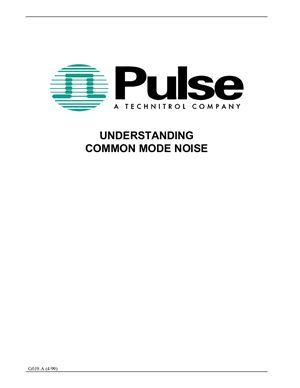7 страниц.
Understanding the difference between common-mode and differential mode signals is crucial for the correct understanding of how Pulse's magnetic interface modules work. Transformers, common-mode chokes and autotransformer terminations play a key role in the reduction of common-mode interference in our LAN and Telecom interface circuits. Common-mode noise plays an important role in the generation of Radio Frequency Interference (RFI) in communications systems using Unshielded Twisted Pair (UTP) cable, so understanding commonmode noise will lead to a better understanding of Electromagnetic Compatibility (EMC) issues conceing magnetic interfaces. It is the purpose of this document to explain the key
characteristics of differential mode and common-mode signals, the principle of operation of
common-mode chokes and auto-transformer terminations, and why common-mode noise on UTP cable leads to noise emissions.
Table of contents:
Introduction.
Differential mode and common mode signals.
Differential Mode signals.
Common Mode signals.
Differential and common mode signals and EMC in UTP systems.
Differential Mode signals and EMC.
Common Mode signals and EMC.
How a transformer conducts common mode noise.
Common mode choke - principle of operation.
Effect of Differential Mode signal on an ideal choke.
Effect of Common Mode signal on an ideal choke.
Center tapped autotransformer - principle of operation.
Effect of Differential Mode signal on an ideal autotransformer.
Effect of Common Mode signal on an ideal autotransformer.
Understanding the difference between common-mode and differential mode signals is crucial for the correct understanding of how Pulse's magnetic interface modules work. Transformers, common-mode chokes and autotransformer terminations play a key role in the reduction of common-mode interference in our LAN and Telecom interface circuits. Common-mode noise plays an important role in the generation of Radio Frequency Interference (RFI) in communications systems using Unshielded Twisted Pair (UTP) cable, so understanding commonmode noise will lead to a better understanding of Electromagnetic Compatibility (EMC) issues conceing magnetic interfaces. It is the purpose of this document to explain the key
characteristics of differential mode and common-mode signals, the principle of operation of
common-mode chokes and auto-transformer terminations, and why common-mode noise on UTP cable leads to noise emissions.
Table of contents:
Introduction.
Differential mode and common mode signals.
Differential Mode signals.
Common Mode signals.
Differential and common mode signals and EMC in UTP systems.
Differential Mode signals and EMC.
Common Mode signals and EMC.
How a transformer conducts common mode noise.
Common mode choke - principle of operation.
Effect of Differential Mode signal on an ideal choke.
Effect of Common Mode signal on an ideal choke.
Center tapped autotransformer - principle of operation.
Effect of Differential Mode signal on an ideal autotransformer.
Effect of Common Mode signal on an ideal autotransformer.

